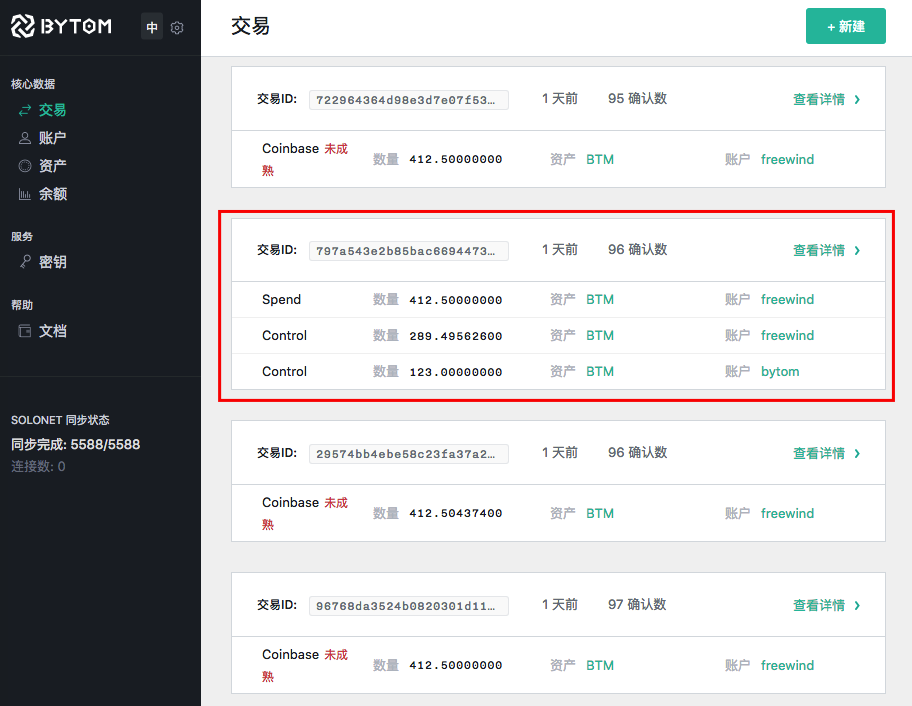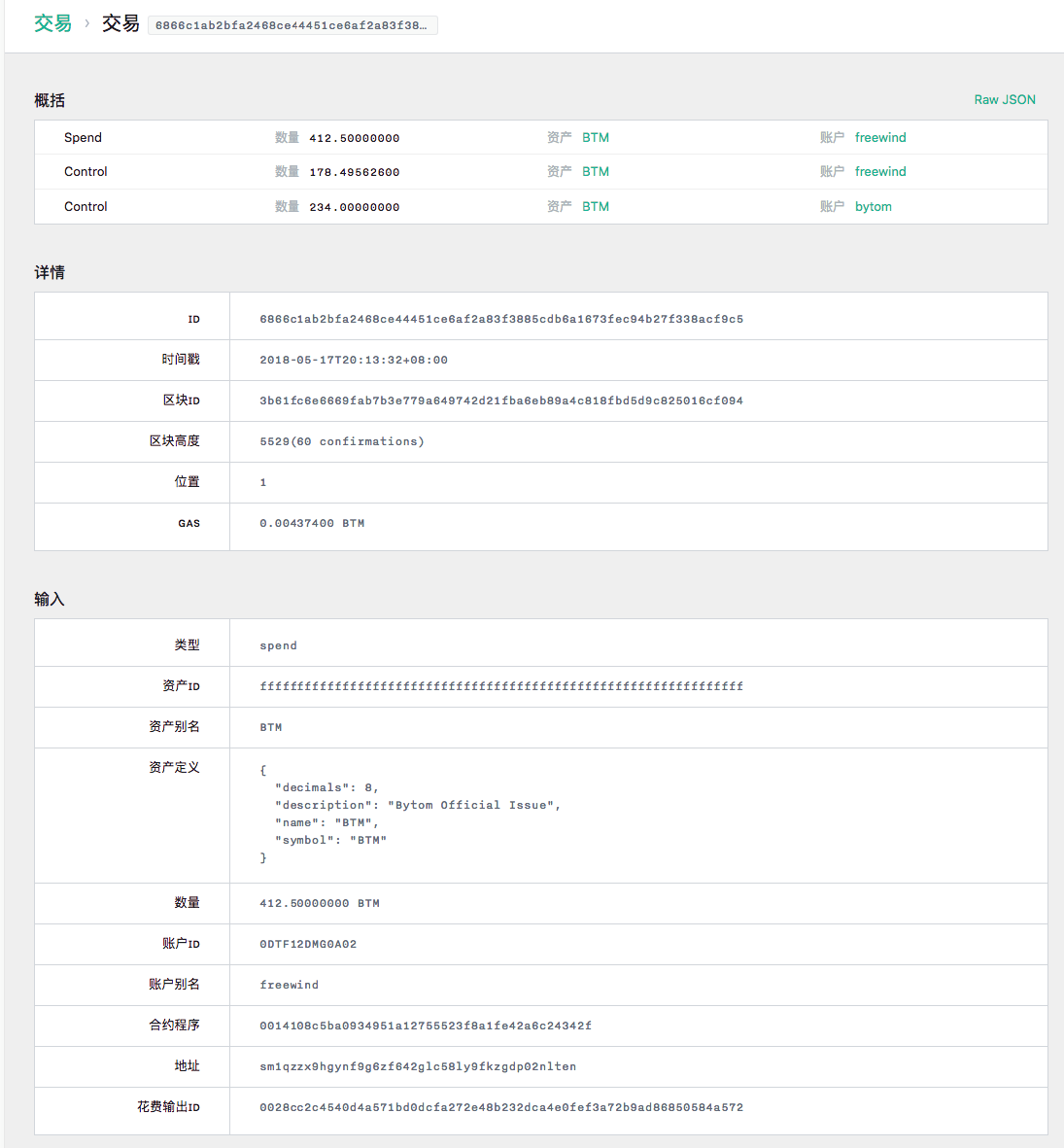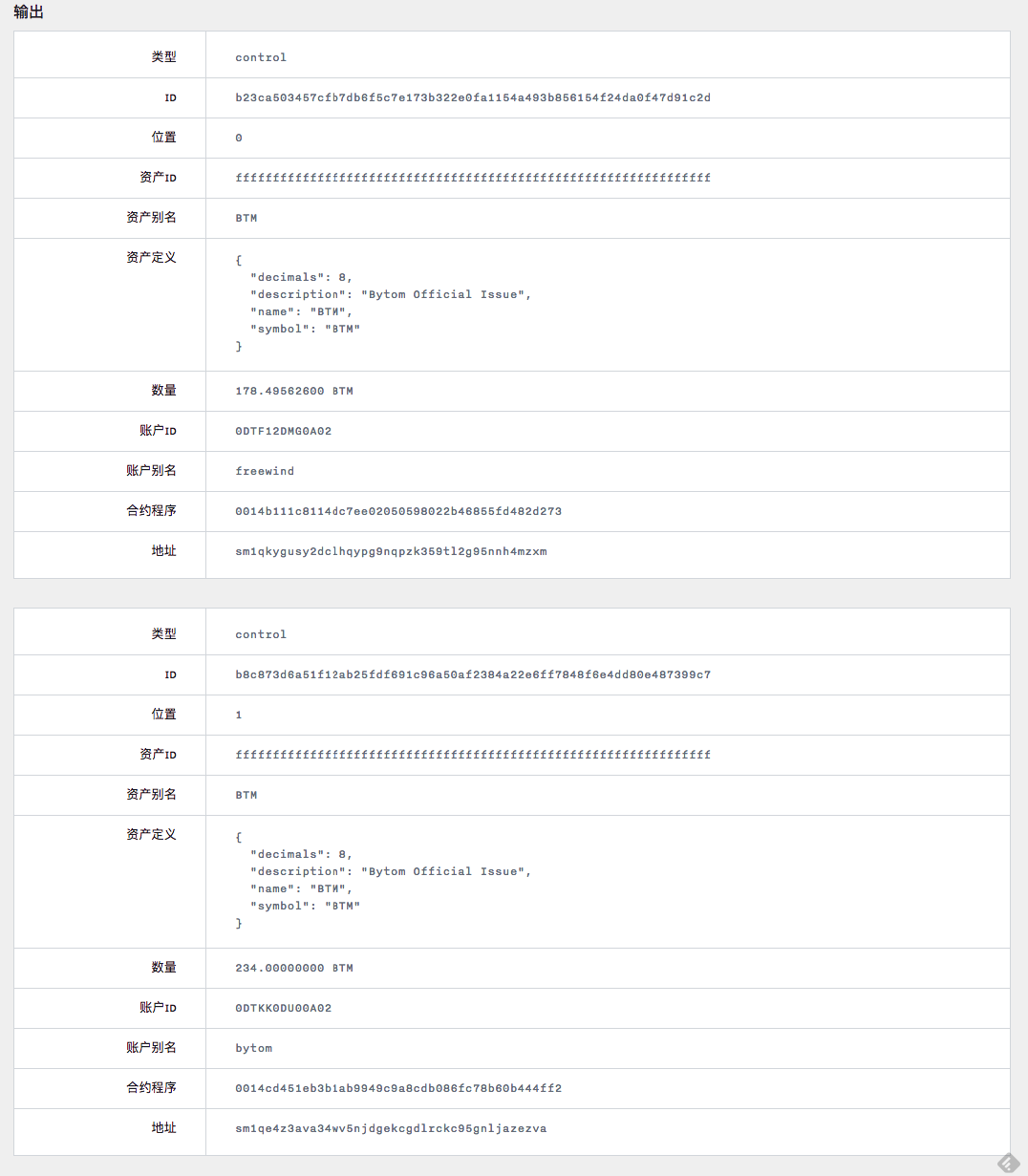您好,登錄后才能下訂單哦!
您好,登錄后才能下訂單哦!
這篇文章主要講解了“比原是怎么通過list-transactions顯示交易信息的”,文中的講解內容簡單清晰,易于學習與理解,下面請大家跟著小編的思路慢慢深入,一起來研究和學習“比原是怎么通過list-transactions顯示交易信息的”吧!
問題:在提交的交易成功完成后,前端會以列表的方式顯示交易信息,它是如何拿到后臺的數據的?也就是下圖是如何實現的:

由于它同時涉及到了前端和后端,所以我們同樣把它分成了兩個小問題:
前端是如何獲取交易數據并顯示出來的?
后端是如何找到交易數據的?
下面依次解決。
我們先在比原的前端代碼庫中尋找。由于這個功能是“列表分頁”顯示,這讓我想起了前面有一個類似的功能是分頁顯示余額,那里用的是src/features/shared/components/BaseList提供的通用組件,所以這邊應該也是一樣。
經過查看,果然在src/features/transactions/components/下面發現了List.jsx文件,且目錄結構跟src/features/balances/components/非常相似,再大略看一下代碼,就能確定使用了一樣的方法。
但是如果回想一下,過程似乎還是有點不同。在顯示余額那里,是我們手動點擊了左側欄的菜單,使得前端的路由轉到了/balances,然后由
src/features/shared/routes.js#L5-L44
const makeRoutes = (store, type, List, New, Show, options = {}) => {
// ...
return {
path: options.path || type + 's',
component: RoutingContainer,
name: options.name || humanize(type + 's'),
name_zh: options.name_zh,
indexRoute: {
component: List,
onEnter: (nextState, replace) => {
loadPage(nextState, replace)
},
onChange: (_, nextState, replace) => { loadPage(nextState, replace) }
},
childRoutes: childRoutes
}
}中的onEnter或者onChange觸發了loadPage,最后一步步調用了后臺接口/list-balances。而這次在本文的例子中,它是在提交了“提交交易”表單成功后,自動轉到了“列表顯示交易”的頁面,會不會同樣觸發onEnter或者onChange呢?
答案是會的,因為在前文中,當submitForm執行后,向后臺的最后一個請求/submit-transaction成功以后,會調用dealSignSubmitResp這個函數,而它的定義是:
src/features/transactions/actions.js#L120-L132
const dealSignSubmitResp = resp => {
// ...
dispatch(push({
pathname: '/transactions',
state: {
preserveFlash: true
}
}))
}可以看到,它最后也會切換前端路由到/transactions,跟顯示余額那里就是完全一樣的路線了。所以按照那邊的經驗,到最后一定會訪問后臺的/list-transactions接口。
這過程中的推導就不再詳說,需要的話可以看前面講解“比原是如何顯示余額的”那篇文章。
最后拿到了后臺返回的數據如何以表格形式顯示出來,在那篇文章中也提到,這里也跳過。
當我們知道了前端會訪問后臺的/list-transactions接口后,我們就很容易的在比原的主項目倉庫中找到下面的代碼:
api/api.go#L164-L244
func (a *API) buildHandler() {
// ...
if a.wallet != nil {
// ...
m.Handle("/list-transactions", jsonHandler(a.listTransactions))
// ...
}可以看到,list-transactions對應的handler是a.listTransactions:
api/query.go#L83-L107
func (a *API) listTransactions(ctx context.Context, filter struct {
ID string `json:"id"`
AccountID string `json:"account_id"`
Detail bool `json:"detail"`
}) Response {
transactions := []*query.AnnotatedTx{}
var err error
// 1.
if filter.AccountID != "" {
transactions, err = a.wallet.GetTransactionsByAccountID(filter.AccountID)
} else {
transactions, err = a.wallet.GetTransactionsByTxID(filter.ID)
}
// ...
// 2.
if filter.Detail == false {
txSummary := a.wallet.GetTransactionsSummary(transactions)
return NewSuccessResponse(txSummary)
}
return NewSuccessResponse(transactions)
}從這個方法的參數可以看到,前端是可以傳過來id,account_id和detail這三個參數的。而在本文的例子中,因為是直接跳轉到/transactions的路由,所以什么參數也沒有傳上來。
我把代碼分成了兩塊,一些錯誤處理的部分被我省略了。依次講解:
第1處是想根據參數來獲取transactions。如果account_id有值,則拿它去取,即某個帳戶擁有的交易;否則的話,用id去取,這個id指的是交易的id。如果這兩個都沒有值,應該是在第二個分支中處理,即a.wallet.GetTransactionsByTxID應該也可以處理參數為空字符串的情況
第2處代碼,如果detail為false(如果前端沒傳值,也應該是默認值false,則將前面拿到的transactions變成摘要,只返回部分信息;否則的話,返回完整信息。
我們先進第1處代碼中的a.wallet.GetTransactionsByAccountID:
wallet/indexer.go#L505-L523
func (w *Wallet) GetTransactionsByAccountID(accountID string) ([]*query.AnnotatedTx, error) {
annotatedTxs := []*query.AnnotatedTx{}
// 1.
txIter := w.DB.IteratorPrefix([]byte(TxPrefix))
defer txIter.Release()
// 2.
for txIter.Next() {
// 3.
annotatedTx := &query.AnnotatedTx{}
if err := json.Unmarshal(txIter.Value(), &annotatedTx); err != nil {
return nil, err
}
// 4.
if findTransactionsByAccount(annotatedTx, accountID) {
annotateTxsAsset(w, []*query.AnnotatedTx{annotatedTx})
annotatedTxs = append(annotatedTxs, annotatedTx)
}
}
return annotatedTxs, nil
}這里把代碼分成了4塊:
第1處代碼是遍歷數據庫中以TxPrefix為前綴的值,其中TxPrefix為TXS:,下面要進行遍歷。這里的DB無疑是wallet這個leveldb
第2處開始進行遍歷
第3處是把每一個元素的Value拿出來,它是JSON格式的,把它轉成AnnotatedTx對象。txIter的每一個元素是一個key-pair,有Key(),也有Value(),這里只用到了Value()
第4處是在當前的這個annotatedTx對象中尋找,如果它的input或者output中包含的帳戶的id等于accountId,則它是我們需要的。后面再使用annotateTxsAsset方法把annotatedTx對象中的asset相關的屬性(比如alias等)補全。
其中AnnotatedTx的定義值得一看:
blockchain/query/annotated.go#L12-L22
type AnnotatedTx struct {
ID bc.Hash `json:"tx_id"`
Timestamp uint64 `json:"block_time"`
BlockID bc.Hash `json:"block_hash"`
BlockHeight uint64 `json:"block_height"`
Position uint32 `json:"block_index"`
BlockTransactionsCount uint32 `json:"block_transactions_count,omitempty"`
Inputs []*AnnotatedInput `json:"inputs"`
Outputs []*AnnotatedOutput `json:"outputs"`
StatusFail bool `json:"status_fail"`
}它其實就是為了持有最后返回給前端的數據,通過給每個字段添加JSON相關的annotation方便轉換成JSON。
如果前端沒有傳account_id參數,則會進入另一個分支,對應a.wallet.GetTransactionsByTxID(filter.ID):
wallet/indexer.go#L426-L450
func (w *Wallet) GetTransactionsByTxID(txID string) ([]*query.AnnotatedTx, error) {
annotatedTxs := []*query.AnnotatedTx{}
formatKey := ""
if txID != "" {
rawFormatKey := w.DB.Get(calcTxIndexKey(txID))
if rawFormatKey == nil {
return nil, fmt.Errorf("No transaction(txid=%s) ", txID)
}
formatKey = string(rawFormatKey)
}
txIter := w.DB.IteratorPrefix(calcAnnotatedKey(formatKey))
defer txIter.Release()
for txIter.Next() {
annotatedTx := &query.AnnotatedTx{}
if err := json.Unmarshal(txIter.Value(), annotatedTx); err != nil {
return nil, err
}
annotateTxsAsset(w, []*query.AnnotatedTx{annotatedTx})
annotatedTxs = append([]*query.AnnotatedTx{annotatedTx}, annotatedTxs...)
}
return annotatedTxs, nil
}這個方法看起來挺長,實際上邏輯比較簡單。如果前端傳了txID,則會在wallet中尋找指定的id的交易對象;否則的話,取出全部(也就是本文的情況)。其中calcTxIndexKey(txID)的定義是:
wallet/indexer.go#L61-L63
func calcTxIndexKey(txID string) []byte {
return []byte(TxIndexPrefix + txID)
}其中TxIndexPrefix是TID:。
calcAnnotatedKey(formatKey)的定義是:
wallet/indexer.go#L53-L55
func calcAnnotatedKey(formatKey string) []byte {
return []byte(TxPrefix + formatKey)
}其中TxPrefix的值是TXS:。
我們再進入listTransactions的第2處,即detail那里。如果detail為false,則只需要摘要,所以會調用a.wallet.GetTransactionsSummary(transactions):
wallet/indexer.go#L453-L486
func (w *Wallet) GetTransactionsSummary(transactions []*query.AnnotatedTx) []TxSummary {
Txs := []TxSummary{}
for _, annotatedTx := range transactions {
tmpTxSummary := TxSummary{
Inputs: make([]Summary, len(annotatedTx.Inputs)),
Outputs: make([]Summary, len(annotatedTx.Outputs)),
ID: annotatedTx.ID,
Timestamp: annotatedTx.Timestamp,
}
for i, input := range annotatedTx.Inputs {
tmpTxSummary.Inputs[i].Type = input.Type
tmpTxSummary.Inputs[i].AccountID = input.AccountID
tmpTxSummary.Inputs[i].AccountAlias = input.AccountAlias
tmpTxSummary.Inputs[i].AssetID = input.AssetID
tmpTxSummary.Inputs[i].AssetAlias = input.AssetAlias
tmpTxSummary.Inputs[i].Amount = input.Amount
tmpTxSummary.Inputs[i].Arbitrary = input.Arbitrary
}
for j, output := range annotatedTx.Outputs {
tmpTxSummary.Outputs[j].Type = output.Type
tmpTxSummary.Outputs[j].AccountID = output.AccountID
tmpTxSummary.Outputs[j].AccountAlias = output.AccountAlias
tmpTxSummary.Outputs[j].AssetID = output.AssetID
tmpTxSummary.Outputs[j].AssetAlias = output.AssetAlias
tmpTxSummary.Outputs[j].Amount = output.Amount
}
Txs = append(Txs, tmpTxSummary)
}
return Txs
}這一段的代碼相當直白,就是從transactions的元素中取出部分比較重要的信息,組成新的TxSummary對象,返回過去。最后,這些對象再變成JSON返回給前端。
那么今天的這個小問題就算解決了,由于有之前的經驗可以利用,所以感覺就比較簡單了。


感謝各位的閱讀,以上就是“比原是怎么通過list-transactions顯示交易信息的”的內容了,經過本文的學習后,相信大家對比原是怎么通過list-transactions顯示交易信息的這一問題有了更深刻的體會,具體使用情況還需要大家實踐驗證。這里是億速云,小編將為大家推送更多相關知識點的文章,歡迎關注!
免責聲明:本站發布的內容(圖片、視頻和文字)以原創、轉載和分享為主,文章觀點不代表本網站立場,如果涉及侵權請聯系站長郵箱:is@yisu.com進行舉報,并提供相關證據,一經查實,將立刻刪除涉嫌侵權內容。